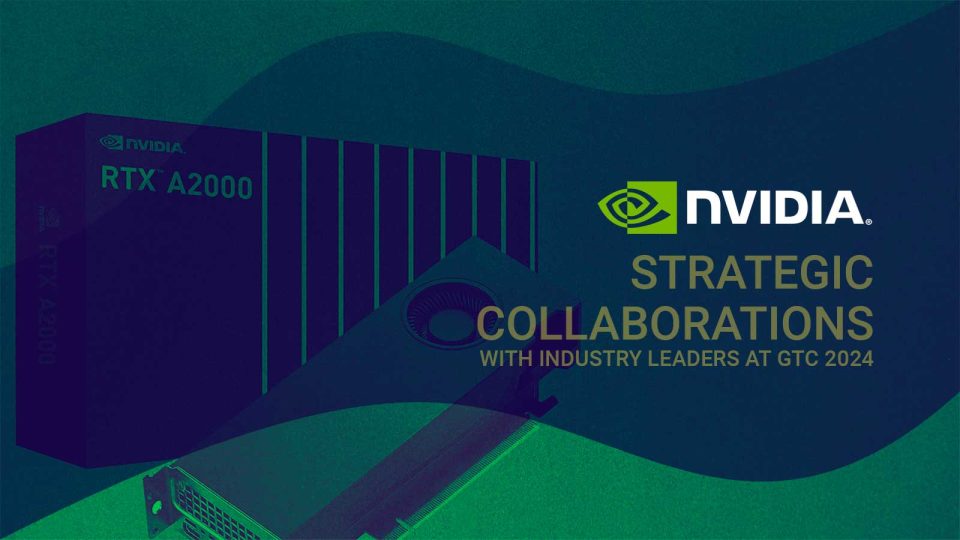NVIDIA GTC 2024 event was a hub for groundbreaking collaborations and innovations as industry giants converged to unveil transformative solutions across various sectors. Partnerships forged at this event promise to reshape industries, from automotive and cybersecurity to cloud computing and AI infrastructure. Each collaboration showcased at GTC 2024 represents a significant stride towards leveraging cutting-edge technologies to drive efficiency, security, and innovation in an increasingly AI-driven world. Let’s delve into the key partnerships announced during NVIDIA’s GTC 2024 event and explore their transformative potential for enterprises worldwide.
Lenovo and NVIDIA Introduce Next-Gen Hybrid AI Solutions at GTC 2024
In collaboration with NVIDIA, Lenovo announced groundbreaking hybrid AI solutions at NVIDIA GTC, enabling every enterprise and cloud to harness the transformative power of tailored generative AI applications. These innovations, born from an expanded engineering partnership, aim to provide accelerated computing capabilities crucial for success in the AI era, empowering businesses across industries to realize AI-driven innovation, digitalization, and growth.
The hybrid solutions, meticulously crafted through engineering collaboration, focus on efficiently bringing AI to customer data, from edge to cloud, thereby realizing Lenovo’s vision of democratizing AI. Optimized to run NVIDIA AI Enterprise software, these solutions now grant developers access to new NVIDIA microservices, further enhancing their AI development capabilities.
In addition, Lenovo unveiled the expansion of its ThinkSystem AI portfolio, featuring powerful systems purpose-built for generative AI, natural language processing (NLP), and large language model (LLM) development. With advanced GPU architectures, liquid cooling technology, and energy-efficient designs, Lenovo’s ThinkSystem AI servers offer unparalleled computational capabilities while ensuring sustainability and cost-effectiveness. Additionally, Lenovo introduced the Lenovo PG8A0N, a cutting-edge 1U node featuring open-loop liquid cooling, poised to revolutionize AI inference and processing with NVIDIA’s latest Grace Blackwell Superchip. Through these innovations, Lenovo and NVIDIA are driving AI forward, enabling businesses worldwide to harness the full potential of AI for accelerated growth and innovation.
Nvidia Expands Microsoft Partnership and Unveils New AI Switches
During Nvidia’s GTC event, Microsoft and Nvidia announced an extended technology partnership to leverage Nvidia’s latest generative AI and Omniverse technologies across Microsoft Azure, Azure AI services, Microsoft Fabric, and Microsoft 365. Satya Nadella, Microsoft’s chairman and CEO, highlighted the significance of this collaboration in making AI advancements tangible, fostering productivity gains for individuals and organizations globally. Jensen Huang, Nvidia’s founder and CEO, echoed this sentiment, emphasizing the transformative potential of AI and the collaborative efforts with Microsoft to unlock innovative solutions.
The partnership entails advancements in AI infrastructure, with deployments of Nvidia Grace Blackwell GB200 and Nvidia Quantum-X800 InfiniBand networking on Azure, aimed at delivering trillion-parameter foundation models for various AI tasks. Microsoft’s Azure NC H100 v5 VM virtual machine, based on the Nvidia H100 NVL platform, has also been announced to cater to midrange training and inferencing needs. Furthermore, Nvidia’s inference microservices will be integrated into Azure, enhancing AI capabilities for users. Additionally, the collaboration expands services for healthcare providers and showcases a digital twin for factory operators utilizing Nvidia Omniverse Cloud APIs. Moreover, Nvidia introduced the X800 series of networking switches, designed for massive-scale AI, marking a milestone in networking capabilities with initial adoption by major cloud platforms like Microsoft Azure, Oracle Cloud Infrastructure, and CoreWeave.
Nvidia Strengthens Collaborations with Chinese Automakers for Self-Driving and Infotainment Systems
During Nvidia’s GTC developer conference in San Jose, California, the company announced a significant expansion of partnerships with leading Chinese automakers, signaling a notable advancement in the development of self-driving vehicles and AI-driven infotainment systems. Emphasizing Nvidia’s deepening ties with automakers aiming to compete globally, the collaborations underscore a strategic move towards integrating Nvidia’s cutting-edge technologies into the automotive landscape.
Key partnerships include Nvidia’s collaboration with BYD, the world’s top electric vehicle manufacturer, to integrate Nvidia’s next-generation in-vehicle chips, Drive Thor, to enhance autonomous driving capabilities and digital functionalities in BYD vehicles. Additionally, Nvidia has forged partnerships with other prominent Chinese automakers like Xpeng, GAC Aion’s Hyper brand, Zeekr, and Li Auto, reflecting a concerted effort to leverage Nvidia’s expertise in self-driving technology and AI for a competitive edge in the automotive sector.
Danny Shapiro, Nvidia’s Vice President for Automotive, highlighted the importance of these collaborations, citing the widespread adoption of Nvidia’s Drive Thor technology across multiple Chinese automakers. Shapiro also pointed out China’s favorable regulatory environment and incentives, which contributed to the momentum behind these partnerships. Furthermore, Nvidia’s collaboration with US-based software company Cerence aims to adapt large language model AI systems for in-car computing, promising advanced voice command systems and improved user experiences, further solidifying Nvidia’s position in the automotive industry.


